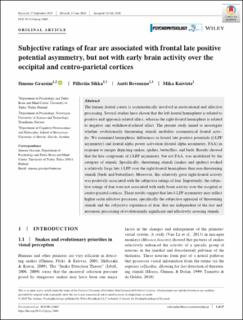| dc.contributor.author | Grassini, Simone | |
| dc.contributor.author | Sikka, Pilleriin | |
| dc.contributor.author | Revonsuo, Antti | |
| dc.contributor.author | Koivisto, Mika | |
| dc.date.accessioned | 2020-09-28T07:36:14Z | |
| dc.date.available | 2020-09-28T07:36:14Z | |
| dc.date.created | 2020-09-02T13:31:44Z | |
| dc.date.issued | 2020 | |
| dc.identifier.issn | 0048-5772 | |
| dc.identifier.uri | https://hdl.handle.net/11250/2679830 | |
| dc.description.abstract | The human frontal cortex is asymmetrically involved in motivational and affective processing. Several studies have shown that the left‐frontal hemisphere is related to positive and approach‐related affect, whereas the right‐frontal hemisphere is related to negative and withdrawal‐related affect. The present study aimed to investigate whether evolutionarily threatening stimuli modulate asymmetrical frontal activity. We examined hemispheric differences in frontal late positive potentials (f‐LPP asymmetry) and frontal alpha power activation (frontal alpha asymmetry, FAA) in response to images depicting snakes, spiders, butterflies, and birds. Results showed that the late component of f‐LPP asymmetry, but not FAA, was modulated by the category of stimuli. Specifically, threatening stimuli (snakes and spiders) evoked a relatively large late f‐LPP over the right‐frontal hemisphere than non‐threatening stimuli (birds and butterflies). Moreover, this relatively great right‐frontal activity was positively associated with the subjective ratings of fear. Importantly, the subjective ratings of fear were not associated with early brain activity over the occipital or centro‐parietal cortices. These results suggest that late f‐LPP asymmetry may reflect higher order affective processes, specifically the subjective appraisal of threatening stimuli and the subjective experience of fear, that are independent of the fast and automatic processing of evolutionarily significant and affectively arousing stimuli. | en_US |
| dc.language.iso | eng | en_US |
| dc.publisher | Wiley | en_US |
| dc.rights | Attribution-NonCommercial-NoDerivatives 4.0 Internasjonal | * |
| dc.rights.uri | http://creativecommons.org/licenses/by-nc-nd/4.0/deed.no | * |
| dc.title | Subjective ratings of fear are associated with frontal late positive potential asymmetry, but not with early brain activity over the occipital and centro‐parietal cortices | en_US |
| dc.type | Peer reviewed | en_US |
| dc.type | Journal article | en_US |
| dc.description.version | publishedVersion | en_US |
| dc.source.journal | Psychophysiology | en_US |
| dc.identifier.doi | 10.1111/psyp.13665 | |
| dc.identifier.cristin | 1826760 | |
| dc.description.localcode | © 2020 The Authors. Psychophysiology published by Wiley Periodicals LLC on behalf of Society for Psychophysiological Research This is an open access article under the terms of the Creative Commons Attribution‐NonCommercial‐NoDerivs License, which permits use and distribution in any medium, provided the original work is properly cited, the use is non‐commercial and no modifications or adaptations are made. | en_US |
| cristin.ispublished | true | |
| cristin.fulltext | original | |
| cristin.qualitycode | 2 | |

